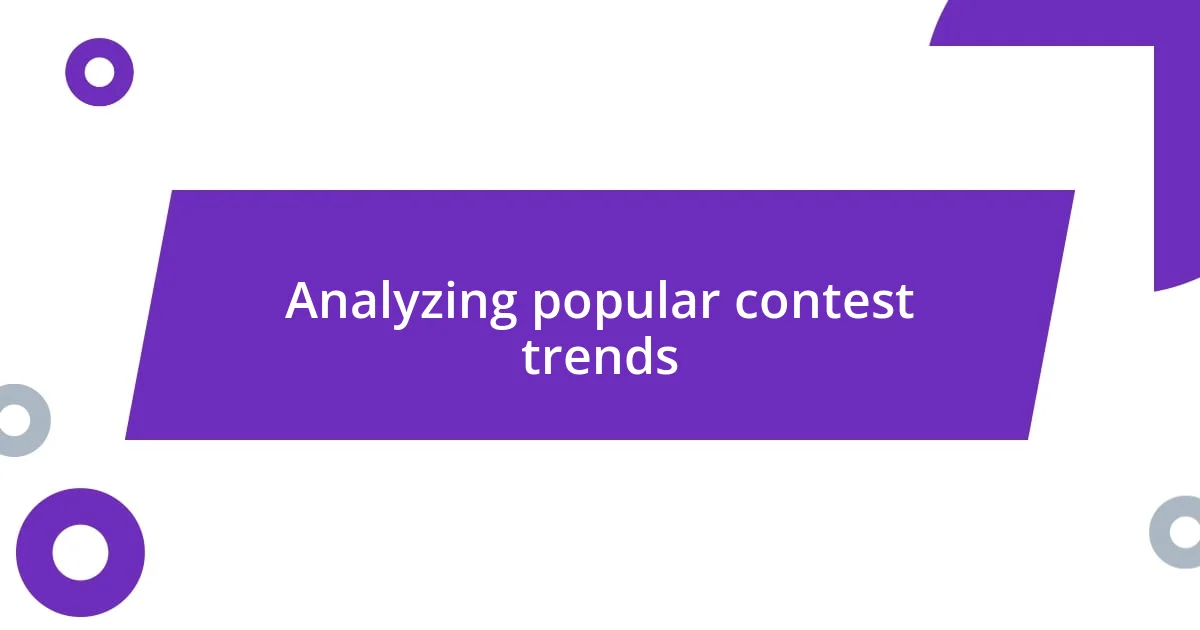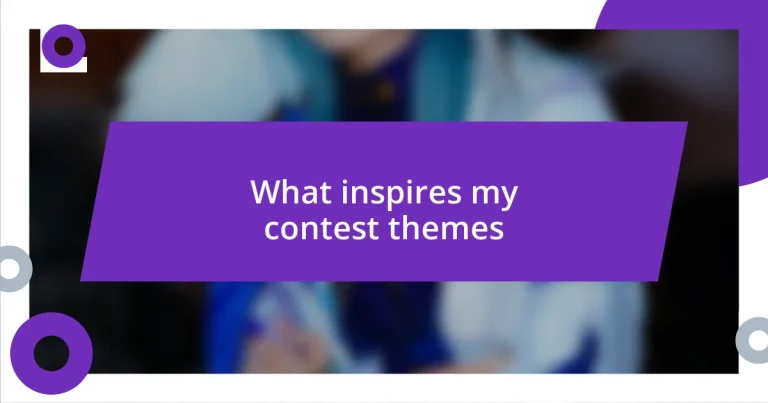Key takeaways:
- Personal experiences and interactions with nature, literature, and art serve as primary sources of inspiration for themes in creative contests.
- Engaging with community feedback leads to more relevant and impactful themes, fostering connection and collaboration among participants.
- Utilizing cultural events and addressing contemporary societal issues enhances the resonance of contest themes, encouraging collective expression and dialogue.

Sources of theme inspiration
When thinking about sources of theme inspiration, I often find that personal experiences stand out the most. For instance, I once visited a small coastal town that embodied the beauty of simplicity, and the tranquility I felt there sparked a theme of “Finding Peace in the Everyday.” It’s fascinating how a single moment can unfold layers of creativity, isn’t it?
Nature is another powerful source that ignites my inspiration. I remember hiking through a vibrant forest, surrounded by a symphony of colors and sounds, which led me to explore themes related to renewal and growth. The connection we have with the earth can drive such meaningful narratives—have you ever considered how a simple walk outside can shift your perspective or even fuel your creativity?
Lastly, literature and art serve as endless wells of inspiration. I often find myself captivated by the emotions evoked through a beautifully written poem or a striking painting. For example, after reading a novel that delved into the struggles of identity, I was compelled to create a theme around self-discovery. Isn’t it amazing how art can prompt us to explore our own stories, all while bridging connections with others?

Personal experiences that influence themes
Reflecting on my own journey, I often realize how pivotal moments shape the themes I explore. For example, after enduring a challenging period of transition, I developed a theme centered around resilience. It struck me how each setback provided an opportunity for growth and introspection, reinforcing the idea that our struggles can be powerful catalysts for creativity.
- A bittersweet farewell to a close friend opened up themes of love and loss, showcasing the beauty in impermanence.
- Volunteering at a local shelter illuminated themes of empathy and community connection that I hadn’t fully appreciated before.
- A serendipitous encounter with an inspiring stranger introduced ideas of hope and unexpected friendships that I wanted to share through my work.
These experiences not only resonate with me personally but also allow me to connect with others on a profound emotional level, encouraging them to reflect on their own narratives.

Analyzing popular contest trends
Understanding popular contest trends can truly open our eyes to what themes resonate with participants. Over the years, I’ve noticed an increasing focus on inclusivity and diversity. This trend reflects our collective desire for storytelling that welcomes all voices. For example, themes that revolve around cultural heritage not only celebrate individuality but also foster a sense of community. Isn’t it invigorating to see how these concepts evolve into shared experiences?
Another trend worth analyzing is the emergence of environmental consciousness in contest themes. Many creators, myself included, have drawn inspiration from pressing global issues, leading to themes that highlight sustainability and the importance of preserving our planet. I recall brainstorming a contest theme that centered on “Nature’s Call,” which encouraged artists to express their relationship with the environment. This wasn’t just an aesthetic choice; it was a rallying call for action, blending creativity with purpose. Have you ever felt the urge to speak out through art about issues you deeply care about?
Lastly, a noticeable trend is the emphasis on mental health and wellness. I’ve seen this topic find its way into contests, prompting participants to explore their inner worlds. Reflecting on my own struggles with anxiety, I once created a theme focused on “Breaking the Silence,” encouraging artists to depict their journey through mental health. This theme not only sparked introspection but also cultivated a larger conversation. It’s remarkable how such vulnerable topics can unite us, isn’t it?
| Trend | Description |
|---|---|
| Inclusivity and Diversity | Focus on themes that celebrate varied cultural narratives and experiences, creating a sense of community. |
| Environmental Consciousness | Themes highlighting sustainability and a connection to nature, encouraging action through creative expressions. |
| Mental Health and Wellness | Exploration of personal struggles, fostering deeper conversations and connections through creative outlets. |

Engaging with community feedback
Engaging with community feedback has been a game-changer for me in shaping contest themes. I vividly recall hosting an art contest where participants expressed an urgent desire for a platform to voice their concerns about social justice. After reading their heartfelt responses, I realized that the theme “Voices for Change” would not only resonate but also empower them. This experience taught me that listening closely to the community opens the door to themes that genuinely reflect their stories and struggles.
In another instance, I presented several potential contest themes to a group of local artists and was taken aback by their enthusiasm for a theme around healing through creativity. Their shared stories highlighted how art can be a refuge during turbulent times, prompting me to pivot and focus my contest around the title “Art as Sanctuary.” I find it fascinating how collective feedback can spark ideas that I may not have considered otherwise, leading to richer, more impactful themes.
I often wonder: what if we took feedback even further and created collaborative spaces for community members to brainstorm themes together? Imagine the burst of creativity that could result! I’ve found that merely sharing ideas often ignites a fire of inspiration, paving the way for themes that are not only relevant but deeply meaningful. Engaging with the community in this way has not only informed my work but has also created lasting bonds and partnerships that extend beyond the contests themselves.

Utilizing cultural events for themes
Cultural events provide a rich tapestry of inspiration for contest themes, allowing creators to tap into the vibrancy of shared traditions and celebrations. I remember my excitement when developing a theme centered around Diwali, the festival of lights. It was captivating to see how participants expressed joy and togetherness through their art, illuminating the importance of light overcoming darkness. Can you feel the warmth and connection that such themes bring to the contest atmosphere?
In another instance, I explored the idea of harnessing cultural events like Pride Month for a contest theme. The theme “Love is Love” not only encouraged participation from the LGBTQ+ community but also invited allies to express their support. Through this experience, I realized that celebrating such pivotal moments fosters inclusion and sparks powerful dialogues. Have you ever thought about how art can serve as a bridge for understanding diverse identities?
Additionally, engaging with traditional cultural narratives can lead to a deeper appreciation of heritage while inspiring contemporary interpretations. I found this especially true when I focused on a theme that celebrated indigenous cultures. The artwork submitted showcased not just vibrant visuals but also poignant stories that honored ancestral wisdom. This left me pondering: how can we further elevate these voices within the creative community? Embracing cultural events in our contests allows us to celebrate our shared humanity and facilitates a continuous dialogue through art.

Creative brainstorming techniques
Creative brainstorming techniques play a crucial role in sparking innovative contest themes. One technique that I’ve found particularly effective is mind mapping. I remember sitting down with a group of fellow creatives, each contributing ideas as we visually connected themes and concepts on a large whiteboard. Watching those connections form was like seeing a web of inspiration unfold before our eyes. Has anyone else experienced that rush of excitement when ideas start to intertwine in unexpected ways?
Another approach I enjoy is the “What If” game. This technique invites you to ask bold questions about your themes, often pushing boundaries in the process. For instance, during one session, I posed the question, “What if art could change the world?” This sparked a lively discussion that led us to create a contest theme titled “Art for a Better Tomorrow.” I can’t help but smile when I think about how a simple question can ignite a flame of creativity that transforms our approach entirely.
Incorporating visual prompts is another game-changing technique. I like to curate a collection of images, quotes, and colors that evoke emotions or ideas related to potential themes. Once during a brainstorming session, I showcased a series of striking photographs depicting urban life. This visual stimulation opened up a dialogue about finding beauty in the chaos and resulted in the theme “Urban Stories.” It’s fascinating how images can evoke memories and ideas that words sometimes struggle to express, wouldn’t you agree?

Implementing themes that resonate
A pivotal aspect of implementing themes that resonate lies in tapping into universal emotions. For instance, I once devised a theme around nostalgia, encouraging participants to share their childhood memories through their art. The flood of heartfelt responses was truly moving; it transformed the contest into a collective remembrance, bridging ages and backgrounds. Have you ever experienced the bittersweet pull of nostalgia that connects us in ways we often overlook?
Another vital consideration is ensuring that the themes reflect contemporary societal issues. Take, for instance, a theme focused on environmental sustainability that I introduced. As artists submitted pieces dealing with climate change and conservation, I felt a sense of urgency and responsibility emanating from their work. It made me appreciate how art can be a powerful tool for awareness and change. Isn’t it profound how these creative expressions can motivate us towards action?
Collaboration also plays a crucial role in creating themes with genuine resonance. I remember partnering with local schools to explore their students’ perspectives on identity. By facilitating workshops and gathering their insights, I was able to develop a theme centered around “Finding Your Voice.” The energy and creativity that flowed from those young artists were invigorating, reminding me of how collaboration can breathe life into a theme. What better way to create a meaningful dialogue than to involve those who will shape the future?














